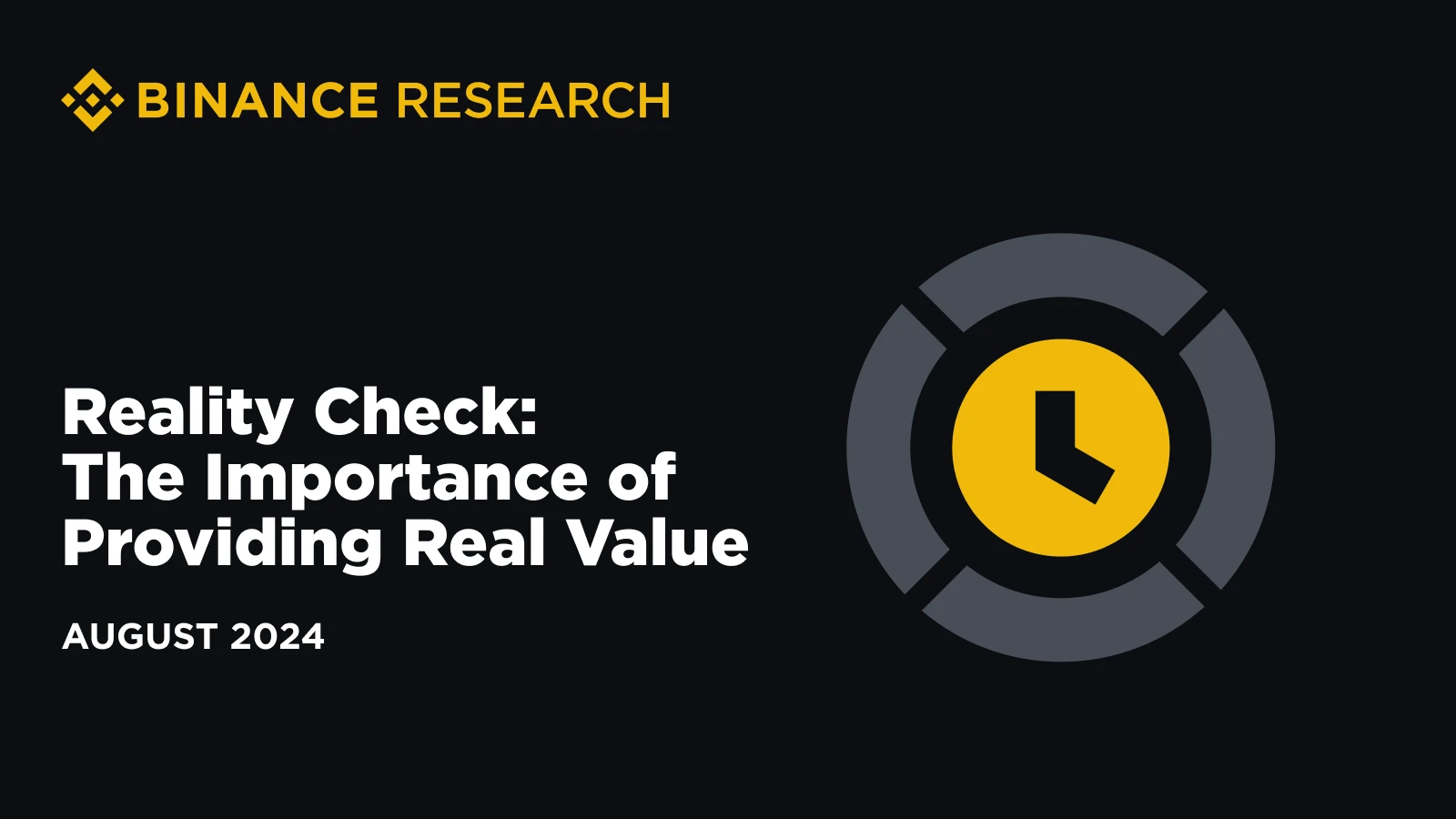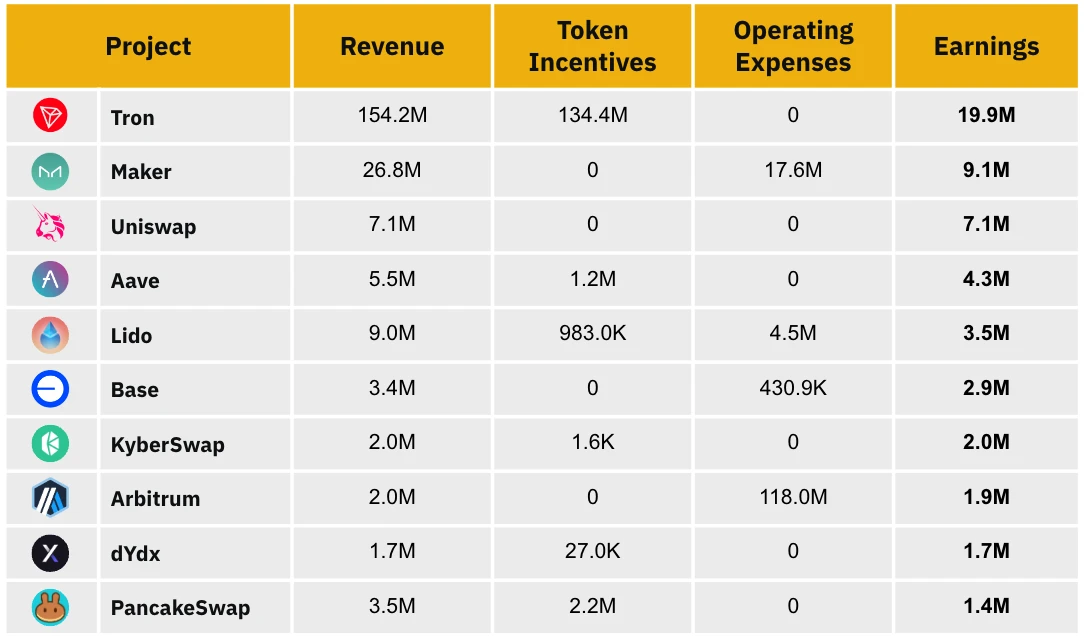Key Points
-
Narratives, emotions, and hype can attract short-term user interest, but are not enough to achieve long-term growth, especially in a bear market. Projects that rely solely on industry narratives or extrinsic rewards tend to attract short-lived users and may struggle in the long run.
-
Projects should focus on delivering real value to users through tangible benefits such as successful use cases and sustainable returns. This user-centric approach can keep users engaged and foster loyalty after the initial hype. Ultimately, providing meaningful value and continuous innovation ensures the long-term development of each project and creates a healthier and more resilient cryptocurrency market.
-
In this report we focus on three (but not exhaustive) ways to arrive at “real value”: real demand, real revenue and profit, and real rate of return.
-
Actual demand refers to the willingness and ability of participants to use and pay for a product or service without relying on external rewards. A strong fit between product and market creates intrinsic demand, allowing the project to generate sustained revenue.
-
Real revenue refers to tangible revenue generated by a project, usually from protocol fees. When combined with healthy token economics and low operating expenses, a project can achieve operational profitability.
-
Real yields in the crypto economy come from tangible income sources and are not entirely dependent on inflationary token issuance.
The challenge of staying interested
Narratives, sentiment, and hype are critical in driving short-term price action and attracting retail interest. However, these factors alone are not sufficient to sustain long-term growth in price and activity . This is more pronounced in sideways or bear markets, when on-chain activity decreases and capital inflows slow. Projects that rely solely on industry narratives or incentivize activity by offering extrinsic rewards (such as points or airdrops) face a more difficult operating environment.
In this context, projects that offer some kind of intrinsic tangible value tend to perform better because they can maintain a base level of activity regardless of market conditions.
Current Situation
Many projects have managed to attract users’ attention by leveraging current trends, such as hot narratives like artificial intelligence, re-staking, or infrastructure layers. However, some of these projects have failed to maintain momentum, and user interest has waned over time, which is difficult to hide the downward trend.
A similar trend is seen in projects that rely heavily or exclusively on extrinsic incentives (such as points systems and airdrop promises) to attract and retain users. While these strategies can generate initial interest and engagement, they often fail to foster long-term commitment. Once the points program is terminated or the tokens are airdropped, users churn, with no intrinsic reason to retain them.
Overall, projects that rely solely on hype or extrinsic rewards tend to attract only a short-lived user base. Moreover, without tangible innovation, these projects will fail to make a significant contribution to the overall development and maturity of the cryptocurrency ecosystem.
Focus on providing real value
In order to achieve sustainable growth, projects must focus on providing real value to users. In this report, we roughly define real value as products or projects that can provide tangible benefits , which can be successful use cases, sustainable yields, or other forms of tangible rewards. We will go into more detail in the next section.
The purpose of providing real value is to keep users engaged after the initial hype, so that they will continue to use the platform even without extrinsic rewards. Over time, this user-centric approach can cultivate loyalty and encourage users to promote the platform to others, thus forming a growth flywheel.
Figure 1: Attract, engage, and delight users to create a growth flywheel
Source: Hubspot.
In fact, by developing solutions that meet real needs and provide intrinsic benefits, projects can cultivate a loyal user base that will remain engaged after short-term incentives. This approach not only ensures the long-term development of individual projects, but also helps to create a healthier and more resilient cryptocurrency market. In the long run, the success of the cryptocurrency ecosystem will depend on the ability of projects to provide meaningful value and drive continuous innovation.
Understand the various aspects of real value
As mentioned above, we broadly define “real value” as products or projects that provide tangible benefits. There are many ways to create value for market participants, but we focus on three main areas:
-
Actual needs : refers to providing a product or service that can meet the users real needs or use cases.
-
Actual income/revenue/cash flow : refers to the financial sustainability generally achieved through the generation of expenses.
-
Actual yield : refers to providing token holders with income generated by a real source of income.
1. Actual needs
Actual demand is the willingness and ability of cryptocurrency participants to use and pay for a specific product or service without providing external rewards (such as airdrop promises and point mining, etc.). This is usually achieved through a close fit between the product and the market, including filling a market gap or need, or providing valuable features and use cases that resonate with many users.
A tight fit between product and market creates intrinsic demand, enabling the project to generate sustained revenue, which in turn provides the necessary resources and user appeal for the project’s continued development to meet the ever-changing needs of end users.
We are witnessing real demand from established industries that continue to grow in user traction and financial metrics. Decentralized Finance (DeFi) is a prime example of this trend, becoming an essential part of the cryptocurrency economy by providing indispensable use case projects:
-
Decentralized trading platforms (DEX) provide users with an infrastructure for on-chain token exchange.
-
Liquidity staking allows users to stake assets while still maintaining liquidity.
-
The money market enables peer-to-peer ( C2C ) asset lending.
-
Cross-chain bridges facilitate the transfer of assets between different chains.
-
Stablecoins provide a stable store of value in the form of crypto assets, which can further be used to pay for services.
In addition to decentralized finance, we also observed that emerging categories have successfully captured strong market demand and attracted a large number of users:
-
Centralized trading platforms provide a comprehensive set of integrated tools, including fiat currency deposits, spot and leveraged trading, financial products, and Web3 wallets.
-
Telegram trading robots optimize the on-chain trading experience and capture the strong demand for memecoin transactions by making the transaction process more convenient and smooth.
-
Prediction markets allow participants to trade shares or tokens based on the outcomes of future events, such as political elections, sporting events, and pop culture happenings.
-
The game captures the real needs of a large number of gamers outside the cryptocurrency community, further introducing innovative in-game economics.
-
On-chain analytics tools collect, organize, and transform raw blockchain data into actionable insights, with some offering additional features through paid subscriptions.
This list is not intended to be exhaustive, but is meant to illustrate the durability they have demonstrated in terms of user appeal and growth over time.
It’s critical to differentiate between projects with strong product-market fit that deliver real, ongoing value and projects that lack sustainable growth potential that rely on short-term interest and artificial demand and don’t solve real problems.
2. Actual income and profits
Real revenue refers to tangible revenue generated by a project, usually from protocol fees. When combined with healthy token economics, a project can achieve profitability and be sustainable in the long term without relying on external capital if it consistently generates enough revenue to cover operating costs.
The profitability of the project can be calculated as follows:
Profit = Revenue – Operating Expenses – Token Issuance
Profit is calculated by subtracting operating expenses and token issuance from the project’s total revenue. As we can see, it’s not just about revenue, a project is only profitable if its total revenue exceeds its costs (including operating expenses and token issuance).
Figure 2: Top 10 protocols based on 30-day profitability
Source: Token Terminal. Data as of August 6, 2024.
Based on the last 30 days of data, the leading protocols in terms of profitability (within Token Terminal’s sample dataset) are Tron, Maker, and Uniswap.
On the other hand, while some projects may be able to generate significant revenue, they may actually be operating at a net loss due to high token issuance or supply-side incentives. Needless to say, we believe it is unreasonable to require all protocols to be immediately profitable, as most have only been around for a few years (or months). Looking at traditional early-stage startups, it is common to use losses to fuel growth in the early stages, and this may work out in the long run. Nonetheless, investors should still evaluate and determine if there is a viable path to profitability in the foreseeable future.
3. Actual rate of return
Real yield comes from a tangible source of income and is not entirely dependent on inflationary token issuance. This is like dividends in traditional finance, where companies return part of their earnings to shareholders. Similarly, in the cryptocurrency economy, real yield is a mechanism for distributing real returns to token holders or users. This is usually in the form of staking rewards, token repricing, or buybacks and burns.
Crypto projects achieve consensus with stakeholders by providing real yields to token holders, such as decentralized exchanges that provide yields to liquidity providers through transaction fees, liquidity staking and re-staking protocols that distribute yields through staking rewards, and synthetic dollar and stablecoin protocols that generate yields through underlying assets (such as treasuries).
Figure 3: Schematic diagram of the actual rate of return distributed by decentralized trading platforms
Source: Binance Research
On the other hand, there are some native tokens whose sole function is governance. While this is fundamentally fine, and these tokens are essential to the functionality and decentralization of the project, they generally do not provide direct financial returns to their holders. The lack of an actual yield means that the value of these tokens is primarily tied to their utility and the success of the associated project.
Finally, investors should also be wary of tokens that primarily earn their yields through inflationary token issuance. Such tokens tend to attract mercenary capital and are inherently unsustainable. Tokens with high inflationary incentives experience a constant increase in token supply, which leads to an imbalance between supply and demand over time. If there is no corresponding increase in token demand, the token price will fall. Instead, we should focus on yield distribution models that can provide tangible returns without relying on inflationary means.
Conclusion
As we continue to witness innovation in the cryptocurrency economy, it is critical to understand the fundamental business models that differentiate long-term sustainable projects from short-term hype. In this emerging cyclical market, projects that provide real value by demonstrating strong product-market fit, consistent revenue/earnings growth, and real yields are more likely to stand the test of time.
In contrast, projects driven by fleeting trends or speculative interest may experience rapid growth in the early stages, but often lack the fundamentals necessary for sustainability. Without a clear value proposition and a solid business model, they will be left without a foothold when market enthusiasm fades.
To achieve long-term growth, we hope to see more projects that focus on providing real value and tangible benefits to users.
This article is sourced from the internet: Reality Check: The Importance of Providing Actual Value
Original author: THE ALTCOIN INVESTOR Original translation: TechFlow 1. Compared with previous cycles, we are still in the early stages . 2. Market adjustments are inevitable. In previous cycles, the market has experienced much deeper corrections. For example, the correction in 2016-17 was between -25% and -35%, while the correction in 2020-21 reached -50% to -63%. Source: Glassnode 3. While liquidity is the same as in 2021, the number of tokens has increased 50 times. In other words, it is now much harder to find tokens that offer 100x returns . 4. Bullish catalysts. Bitcoin ETFs continue to see inflows Ethereum ETF is coming soon Regulatory shift Interest rates are at historical highs, and have already started to fall in the EU and Canada Stocks at all-time highs Gold nears…











